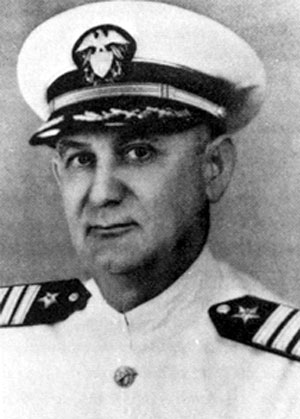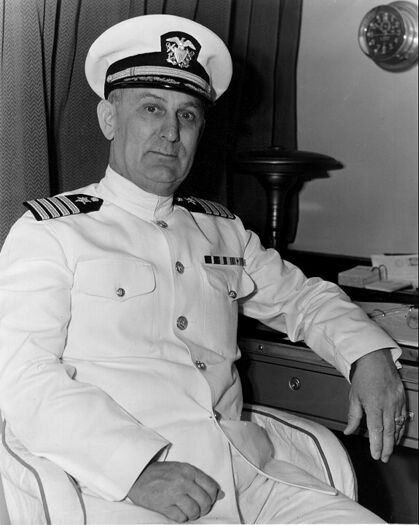ROBERT H. ENGLISH, RADM, USN
Robert English '11
Lucky Bag
From the 1911 Lucky Bag:
Robert Henry English
Warrenton, Georgia
"Bob" "Stumpy"
PERHAPS the one best bet about Bob is that he is in earnest; he's in earnest about everything he does,—and he is doing something most all the time. Not that he is "sober-sided," but Bob takes the serious things of life a little more than the rest of us, and that is one reason why he accomplishes things. He has a well-formulated opinion on every subject and is not averse to telling just what that opinion is. This very self-reliance is what probably kept him off the baseball team one year, for he made up his mind that the proper way to bat—but that's a long story. Bob is one of those quiet and unobtrusive fussers who does not flutter exclusively around one flame but is mildly singed by a whole galaxy of candles. However, we venture to predict that he will be one of our first Benedicts; Bob's instincts are essentially domestic.
"What's the tempertoor of the armatoor?"
Baseball (4, 3, 2). White (N). White N 2d (4, 2).
Robert Henry English was born at Warrenton, Ga., January 16, 1888. He graduated from the Warrenton High School, and entered Georgia Institute of Technology in 1904 where he passed two years, becoming a member of the Gamma Alpha Chapter of Sigma Nu Fraternity.

Robert Henry English
Warrenton, Georgia
"Bob" "Stumpy"
PERHAPS the one best bet about Bob is that he is in earnest; he's in earnest about everything he does,—and he is doing something most all the time. Not that he is "sober-sided," but Bob takes the serious things of life a little more than the rest of us, and that is one reason why he accomplishes things. He has a well-formulated opinion on every subject and is not averse to telling just what that opinion is. This very self-reliance is what probably kept him off the baseball team one year, for he made up his mind that the proper way to bat—but that's a long story. Bob is one of those quiet and unobtrusive fussers who does not flutter exclusively around one flame but is mildly singed by a whole galaxy of candles. However, we venture to predict that he will be one of our first Benedicts; Bob's instincts are essentially domestic.
"What's the tempertoor of the armatoor?"
Baseball (4, 3, 2). White (N). White N 2d (4, 2).
Robert Henry English was born at Warrenton, Ga., January 16, 1888. He graduated from the Warrenton High School, and entered Georgia Institute of Technology in 1904 where he passed two years, becoming a member of the Gamma Alpha Chapter of Sigma Nu Fraternity.
Loss
Robert was lost on January 21, 1943, when the aircraft he was aboard crashed near Ukiah, California while enroute from Pearl Harbor to San Francisco. The flying boat, a Pan Am Clipper, was being operated by Pan Am employees but was a contracted Navy flight, and all ten passengers were Navy officers.
Other Information
From The US Naval Institute:
On 21 January 1943, a Pan Am clipper operating for the Naval Air Transport Service was on a flight from Pearl Harbor to San Francisco. On board the transport aircraft was Rear Admiral Robert H. English, Commander, Submarines, Pacific Fleet, headed for a conference at Mare Island, together with three of his senior staff officers. Once matters had been completed at San Francisco, English and the others were scheduled for inspection trips to U.S. submarine facilities at Kodiak, Dutch Harbor, and then San Diego.
Bob English, a 1911 graduate of the Naval Academy, was a veteran submariner. Awarded a Navy Cross as Commanding Officer of the submarine O-4 during World War I, English also had received a Letter of Commendation from the Secretary of the Navy, while stationed at the New York Navy Yard in October 1918, for entering the after battery compartment of submarine O-5 following an internal explosion, in order to rescue her disabled skipper Lieutenant Commander G. A. Trever ('09) from being burned to death. Assigned as Commander, Submarines, Pacific Fleet in May 1942, Rear Admiral English had experienced a rocky eight months in command. A tough taskmaster, he had relieved a number of his submarine skippers for their repeated failures to sink their Japanese merchant shipping targets, unaware that a significant part of the problem had to do with the faulty Mark XIV torpedoes they were using. Yet he was seen by many of his contemporaries and his seniors as a hardworking officer who was achieving positive results with his submarine campaign.
As English’s plane approached San Francisco that morning, it ran into a bad storm, with high winds, stinging rain, and fog, and radio contact with the control tower was lost. When next heard from, the aircraft, still in the storm, was located well north of San Francisco, over Bell Valley some 115 miles away. Navy authorities later surmised that the crew was trying to find Clear Lake to make an emergency landing. But this was not to be. The Pan Am clipper struck a 2,000-foot ridge near Boonville, California and exploded, killing its ten passengers and nine civilian crewmen instantly. It took ten days for the bodies and the wreckage to be found in the rugged hills. Admiral English was buried with full military honors at Arlington National Cemetery on 9 February 1943. Just over a month later, Navy Secretary Frank Knox presented his widow with the Distinguished Service Medal Admiral English had been posthumously awarded for his “exceptionally meritorious service” as Commander, Submarines, Pacific Fleet.
From researcher Kathy Franz:
On October, 7, 1918, Robert saved Lt. Cmdr. George Trever (’09) who was in the battery compartment of the O-5 when it exploded in the New York navy yard in Brooklyn. Robert was on the O-4 tied next to it and wore a gas mask to rescue Trever. However, Trever later died on October 14.
In July 1941, Robert was ordered to command the cruiser Helena and was aboard when the Japanese attacked Pearl Harbor on December 7. In March 1942, he was ordered in command of a submarine squadron and of the submarine base in Pearl Harbor. In May, he was appointed to the rank of rear admiral and ordered in command of the submarine force.
He was survived by his wife, Eloise, two daughters (one of whom, also Eloise, was an Ensign in the WAVES), and a son (who served as a Navy officer in World War II). Robert is buried in Arlington National Cemetery.
Photographs
Career
From Wikipedia:
English was born in Warrenton, Georgia, and he was a member of the United States Naval Academy class of 1911. Early in his naval career he became a submariner. In 1917, while commanding the submarine USS O-4 (SS-65), he received the Navy Cross for his great heroism in rescuing an officer trapped in the submarine USS O-5 (SS-66) after an explosion.
After a series of important assignments, he became commanding officer of the light cruiser USS Helena (CL-50), and during the Japanese attack on Pearl Harbor in Hawaii on 7 December 1941 was one of the first to bring his ship into action.
From The Pacific War Encyclopedia:
Robert English assumed command of Pacific Fleet submarines in March 1942. Described as an aloof, tough-minded officer, he replaced a large number of the less aggressive submarine commanders in his squadrons. His endorsements on patrol reports were so harsh that a subversive poem began circulating amongst his submarine skippers, alleging that desk commanders were out of touch with real conditions on the firing line.
English maintained confidence in the Mark VI magnetic torpedo exploder much longer than was warranted, discounting the complaints of the sub skippers about their torpedoes as excuses for timid hunting and poor shooting. His employment of his submarines is also subject to criticism; they achieved little at the Battle of Midway (though much was claimed at the time) and their placement close to bases and ports ensured that the submarines would encounter heavy antisubmarine patrolling.
From Hall of Valor:
The President of the United States of America takes pleasure in presenting the Navy Cross to Lieutenant Commander Robert Henry English (NSN: 0-7724), United States Navy, for distinguished service as Commanding Officer of the U.S.S. 0-4, engaged in the important, exacting and hazardous duty of patrolling the waters infested by enemy submarines, destroyers and mines, protecting vitally important convoys of troops and supplies and in offensive and defensive action, vigorously and unremittingly prosecuted against all forms of enemy naval activity during World War I.
Service: Navy
Division: U.S.S. O-4
From Hall of Valor:
The President of the United States of America takes pleasure in presenting a Gold Star in lieu of a Second Award of the Navy Cross to Lieutenant Commander Robert Henry English (NSN: 0-7724), United States Navy, for his heroic conduct upon the occasion of the explosion on the U.S.S. 0-5. At the risk of his own life Lieutenant Commander English entered the after battery compartment, which was filled with smoke and debris from the exploding batteries, and rescued Lieutenant Commander G. A. Trever, U.S.N., from being burned to death.
Service: Navy
Division: U.S.S. O-5
From Hall of Valor:
The President of the United States of America takes pride in presenting the Navy Distinguished Service Medal (Posthumously) to Rear Admiral Robert Henry English (NSN: 0-7724), United States Navy, for exceptionally meritorious and distinguished service in a position of great responsibility to the Government of the United States, as Commander, Submarines, Pacific Fleet, during World War II. In that position of great responsibility, he directed the operations of his command with marked skill and resourcefulness, as a result of which heavy damage was inflicted on enemy ships and shipping. His example of tenacity and devotion to duty was in large part responsible for the high degree of combat efficiency attained by his command.
General Orders: Commander in Chief: Serial 1158)
Service: Navy
Division: Submarines, Pacific Fleet
Namesake
USS English (DD 696) was named for Robert; the ship was sponsored by his daughter, Eloise.
Related Articles
Donald Godwin '11, Robert Smith '20, John Crane '26, Francis Black '26, William Myers '26, John Coll '27, and George Stone '31 were also lost in the crash of Pan Am Flight 1104. Eight of the ten passengers were Naval Academy graduates.
The "Register of Commissioned and Warrant Officers of the United States Navy and Marine Corps" was published annually from 1815 through at least the 1970s; it provided rank, command or station, and occasionally billet until the beginning of World War II when command/station was no longer included. Scanned copies were reviewed and data entered from the mid-1840s through 1922, when more-frequent Navy Directories were available.
The Navy Directory was a publication that provided information on the command, billet, and rank of every active and retired naval officer. Single editions have been found online from January 1915 and March 1918, and then from three to six editions per year from 1923 through 1940; the final edition is from April 1941.
The entries in both series of documents are sometimes cryptic and confusing. They are often inconsistent, even within an edition, with the name of commands; this is especially true for aviation squadrons in the 1920s and early 1930s.
Alumni listed at the same command may or may not have had significant interactions; they could have shared a stateroom or workspace, stood many hours of watch together… or, especially at the larger commands, they might not have known each other at all. The information provides the opportunity to draw connections that are otherwise invisible, though, and gives a fuller view of the professional experiences of these alumni in Memorial Hall.
January 1912
January 1913
January 1915
January 1916
January 1917
March 1918
January 1919
January 1920
January 1921
January 1922
May 1923
July 1923
September 1923
November 1923
January 1924
March 1924
May 1924
July 1924
September 1924
November 1924
January 1925
March 1925
May 1925
July 1925
October 1925
January 1926
October 1926
January 1927
April 1927
October 1927
January 1928
April 1928
July 1928
October 1928
January 1929
April 1929
July 1929
October 1929
January 1930
April 1930
October 1930
1LT David Claude '24 (Marine Barracks, Naval Academy)
January 1931
April 1931
July 1931
LT Joseph Severyns, Jr. '20
LT Samuel Arthur '20
LT Robert Smith '20
LT Paul Slawson '20
LT John Jones '21
LT John French '22
LTjg William Hobby, Jr. '23
October 1931
January 1932
April 1932
LCDR Lyman Swenson '16
LT Samuel Arthur '20
LT Robert Smith '20
LT Paul Slawson '20
LTjg William Hobby, Jr. '23
LT John Welch '23
LT Louis Drexler, Jr. '23
October 1932
January 1933
April 1933
July 1933
October 1933
April 1934
July 1934
October 1934
January 1935
April 1935
October 1935
January 1936
April 1936
July 1936
January 1937
April 1937
September 1937
January 1938
July 1938
January 1939
October 1939
June 1940
November 1940
April 1941
Memorial Hall Error
Robert, along with his classmate Donald Godwin '11, are the only two Naval Academy alumni who perished in this crash who are not included in Memorial Hall. Their loss is clearly an operational one, and six other alumni who were aboard are listed with their classmates.

The "category" links below lead to lists of related Honorees; use them to explore further the service and sacrifice of alumni in Memorial Hall.


